|
 NATURAL ENVIRONMENT NATURAL ENVIRONMENT
Hong Kong’s topography and subtropical climate provide a wide range of habitats that support a rich variety of flora and fauna. Scenically, it has a great deal to offer – a landscape rising from sandy beaches and rocky foreshores to a height of almost 1 000 metres, with woodlands and hilly areas covered by open grassland, as well as a variety of scenic vistas rarely seen in such a small locale.
 In Hong Kong, there are more than 3 100 species of vascular plants, of which about 2 100 are native; some 50 species of mammals; 480 species of birds; 160 species of freshwater fish; 80 species of reptiles and more than 20 amphibian species. Insect diversity is also very high with more than 230 species of butterflies and 110 types of dragonflies. In Hong Kong, there are more than 3 100 species of vascular plants, of which about 2 100 are native; some 50 species of mammals; 480 species of birds; 160 species of freshwater fish; 80 species of reptiles and more than 20 amphibian species. Insect diversity is also very high with more than 230 species of butterflies and 110 types of dragonflies.
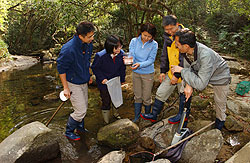 ECOLOGICAL SURVEYS AND DATABASE ECOLOGICAL SURVEYS AND DATABASE
The Department has been conducting a territory-wide ecological survey programme since 2002 with a view to establishing and updating an ecological database for the whole of Hong Kong. The survey programme covers all major habitats of high conservation value in Hong Kong, including the location, status and composition of fung shui woods, as well as the distribution and abundance of selected animal groups. As at March 2006, more than 55 000 records of about 1 500 species of plants and animals had been collected, verified, and stored in a database for internal reference.
 The survey findings confirm that Hong Kong has a rich biodiversity, including species new to Hong Kong and even new to science. For example, a new species of bat – the Greater Bamboo Bat – was discovered in July 2005, raising the total number of bat species in Hong Kong to 26. Halophila minor, previously unknown to Hong Kong, was confirmed to be the fifth local seagrass species. The findings also suggest that our protected areas encompass a very significant portion of this biodiversity. For the species groups surveyed and analysed, more than 95% of the terrestrial and freshwater representatives that are regularly seen in Hong Kong have representative population(s) inside our protected areas. The survey findings confirm that Hong Kong has a rich biodiversity, including species new to Hong Kong and even new to science. For example, a new species of bat – the Greater Bamboo Bat – was discovered in July 2005, raising the total number of bat species in Hong Kong to 26. Halophila minor, previously unknown to Hong Kong, was confirmed to be the fifth local seagrass species. The findings also suggest that our protected areas encompass a very significant portion of this biodiversity. For the species groups surveyed and analysed, more than 95% of the terrestrial and freshwater representatives that are regularly seen in Hong Kong have representative population(s) inside our protected areas.
To boost public interest in local biodiversity and win public support for nature conservation, the Department has established an online database on representative species and habitats for public access at Hong Kong Biodiversity Online (www.hkbiodiversity.net). The Department is also developing a centralised database using the Geographical Information System, which will incorporate survey data and ecological information available from other sources.
As a follow up to these surveys, the Department is committed to long-term, continuous monitoring and repeated surveys to update its database. The Department will also develop plans for the conservation of important species and habitats identified in the surveys.
MAI PO INNER DEEP BAY RAMSAR SITE
Ecological Monitoring
Since August 2001, the Department has implemented the Mai Po Inner Deep Bay Ramsar Site Ecological Monitoring Programme. This long-term monitoring programme aims to collect ecological baseline information on the marine benthic communities, over-wintering waterbird counts and the extent of habitation at the Ramsar Site.
The Laboratory of Environmental Toxicology at the University of Hong Kong has been appointed contractor to carry out the monitoring programme. All ecological data is cross-referenced with environmental data, including water quality, sediment quality and the mudflat sedimentation rate, for analysis of change and interaction of these parameters. The data collected in the programme serves as a record of the ecological conditions of the Ramsar Site.
Waterbird Monitoring
 The counting of waterbirds in the Ramsar Site is carried out on a monthly basis by the Hong Kong Bird Watching Society in collaboration with the Department as part of the baseline monitoring programme. The counting of waterbirds in the Ramsar Site is carried out on a monthly basis by the Hong Kong Bird Watching Society in collaboration with the Department as part of the baseline monitoring programme.
From October 2005 to March 2006, the highest count of waterbirds at the Ramsar Site was about 59 500, including 4 300 egrets and herons, 17 700 ducks and grebes, 14 400 gulls and terns, 12 000 shorebirds, 600 rails and coots, and 10 300 cormorants.
The population of winter waterbirds in the Ramsar Site has been stable in the range of 50 000 to 60 000 over the last nine years.
BLACK-FACED SPOONBILLS
The Black-faced Spoonbill is a globally endangered species that can only be found in the East Asia region. Last year, over 20% of the global population made the Mai Po Inner Deep Bay Ramsar Site their winter or stop-over migration site.
Accordingly, maintaining the Ramsar Site in a favourable condition for the wintering Black-faced Spoonbills in Hong Kong has been an important aspect of the territory’s conservation plan since 2001. Other parts of the plan include safeguarding the site; species and habitat management; monitoring and research; education and training; as well as achieving regional cooperation.
The Department joined the international global census on Black-faced Spoonbills in the East Asia region, which was coordinated by the Hong Kong Bird Watching Society. In the winter of 2005-06, 1 679 Black-faced Spoonbills were counted in the East Asia region. During the winter of 2005-06, the wintering population in the Deep Bay area, i.e. including Hong Kong and Shenzhen, reached a peak of 346 birds in January 2006 which is a new high for the area. These findings indicate that the Ramsar Site has the second largest number of wintering Black-faced Spoonbills in the East Asia region.
GREEN TURTLES
Found at Sham Wan beach on Lamma Island, the Green Turtle is the only species of sea turtle that breeds regularly in Hong Kong. The Department has implemented a Green Turtle Conservation Programme to protect this endangered species, including designating the Sham Wan beach as a restricted area during the nesting period from June to October each year. The programme includes such activities as the clearing of climbers and marine garbage that may obstruct Green Turtles from nesting, regular patrols by nature wardens and public education activities that focus on sea turtle conservation. During 2005-06, there was no record of Green Turtle nesting in Hong Kong.
There are five species of sea turtles, namely the Green Turtle, Hawksbill, Leatherback, Loggerhead, and Olive Ridley, which are common in tropical and sub-tropical zones and may occasionally be found stranded or injured in Hong Kong waters or coastal areas. In such events, the Department arranges site inspections and veterinary treatments as necessary.
WILD MONKEYS
 To control the wild monkey population in Hong Kong, a field trial of contraceptive treatment for three target groups of wild monkeys has been ongoing since 2003. As the wild monkeys have cleverly learned to avoid the traps, the progress of the trial has been delayed. Assessment on the effectiveness of the treatment will be conducted as soon as the target number of monkeys treated with contraceptive is achieved. To control the wild monkey population in Hong Kong, a field trial of contraceptive treatment for three target groups of wild monkeys has been ongoing since 2003. As the wild monkeys have cleverly learned to avoid the traps, the progress of the trial has been delayed. Assessment on the effectiveness of the treatment will be conducted as soon as the target number of monkeys treated with contraceptive is achieved.
Sha Tin District is naturally the main residential area where stray monkeys have been reported, as it is right next to Hong Kong’s wild monkey habitat. The Department has deployed staff and traps to catch these wandering animals. To minimise future problems, the Department has advised local estate management companies to keep food and rubbish out of reach from stray monkeys and to urge residents not to feed the animals. Seminars and on-site demonstrations on the correct methods, techniques and equipment for chasing monkeys back into their woodland habitat have also been arranged for the staff of estate management companies in Sha Tin.
CONTROL OF TRADE IN ENDANGERED SPECIES
The Protection of Endangered Species of Animals and Plants Bill, which will replace the existing Animals and Plants (Protection of Endangered Species) Ordinance, was introduced into the Legislative Council in April 2005. It was passed by the Legislative Council on March 1, 2006 and came into operation in 2006.
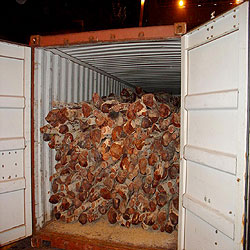 Efforts to combat the illegal trade in endangered species continues. During the report period, over 450 seizures were made, including a shipment of 229 pieces (503 kg) of ivory tusks and 556 kg of hawksbill sea turtle scales from Tanzania, 5 067 head of frozen pangolin carcasses and 2 336 kg of pangolin scales from Indonesia and Malaysia, and four containers (78 tonnes) of red sandalwood from India and Malaysia. Efforts to combat the illegal trade in endangered species continues. During the report period, over 450 seizures were made, including a shipment of 229 pieces (503 kg) of ivory tusks and 556 kg of hawksbill sea turtle scales from Tanzania, 5 067 head of frozen pangolin carcasses and 2 336 kg of pangolin scales from Indonesia and Malaysia, and four containers (78 tonnes) of red sandalwood from India and Malaysia.
Publicity and education work on endangered species protection was stepped up to promote public awareness of the need to conserve species and enact related controls. These activities included visits to the Endangered Species Resource Centre, talks to schools as well as displays at the airport and border control points. Under a joint education programme between Hong Kong and Guangdong Province, a trader seminar and a training course were also held. In addition, a radio play competition on endangered species protection was organised with the support of RTHK Radio 2 to promote students’ awareness of endangered species. The competition received 49 entries from 28 secondary schools and the winning play was later broadcast on RTHK Radio 2. To apprise traders and the general public of the new Ordinance, a series of publicity activities were planned and implemented, including circular letters to traders, announcements on the Department’s website, advertisements on public transportation, roving exhibitions at public venues, new pamphlets and posters, and broadcasts on radio and TV.
HONG KONG WETLAND PARK
The Phase I exhibition pavilion of the Hong Kong Wetland Park was closed in May 2005 for renovation to become a Ticket Office for the Park’s Phase II development. During April and May 2005, a total of 13 836 people visited the Phase I exhibition pavilion. Guided tours were arranged for 5 254 participants from 171 schools and community organisations.
Exhibition fabrication works at the Visitor Centre of the Phase II development commenced in late April 2005. There are now three exhibition galleries, namely Living Wetland, Human Culture and Wetland Challenge, which collectively show the biodiversity, civilisation and conservation issues related to wetlands around the world. During the report period, the Department continued to conduct ecological surveys in the Park, proactively managing habitats to improve their ecological functions.
HONG KONG HERBARIUM AND FLORA CONSERVATION
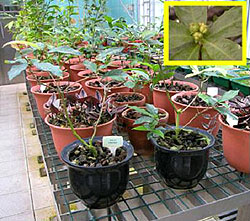 The Hong Kong Herbarium is responsible for the systematic collection, identification and maintenance of plant specimens of Hong Kong flora. Two species new to science were added to the flora of Hong Kong: the Hong Kong Syndiclis (Syndiclis hongkongensis Xia, Deng & Yip) and the Glandular Beilschmiedia (Beilschmiedia glandulosa Xia, Wei & Deng) of the Laurel family (Lauraceae). The descriptions of the species have been published in botanical literature and will also be covered in Volume 1 of the Flora of Hong Kong, which will be jointly produced by the Hong Kong Herbarium together with the South China Botanical Garden. In addition to the role of a resource centre for plant workers, the Herbarium aims to enhance public awareness of local flora through guided visits, educational leaflets and various publications. My Story with Hollies, a book written by the world-renowned taxonomist Prof. Hu Shiu-ying with the assistance of the Herbarium on photography and editing, has also been produced to enhance local understanding and interest in local botany. The Hong Kong Herbarium is responsible for the systematic collection, identification and maintenance of plant specimens of Hong Kong flora. Two species new to science were added to the flora of Hong Kong: the Hong Kong Syndiclis (Syndiclis hongkongensis Xia, Deng & Yip) and the Glandular Beilschmiedia (Beilschmiedia glandulosa Xia, Wei & Deng) of the Laurel family (Lauraceae). The descriptions of the species have been published in botanical literature and will also be covered in Volume 1 of the Flora of Hong Kong, which will be jointly produced by the Hong Kong Herbarium together with the South China Botanical Garden. In addition to the role of a resource centre for plant workers, the Herbarium aims to enhance public awareness of local flora through guided visits, educational leaflets and various publications. My Story with Hollies, a book written by the world-renowned taxonomist Prof. Hu Shiu-ying with the assistance of the Herbarium on photography and editing, has also been produced to enhance local understanding and interest in local botany.
The Department pays special attention to the conservation of rare and precious plants. The endemic plant Hong Kong Croton (Croton hancei Benth.) was re-discovered in 1997 by Herbarium staff on Tsing Yi Island after an absence of almost 150 years. As the only known native habitat in the world where C. hancei currently exists, the Tsing Yi site is thus of great scientific interest. Besides in-situ conservation by listing the site as a SSSI in 2005, the species has also been conserved ex-situ in a new greenhouse at Tai Tong as well as at the Shing Mun Arboretum to ensure its survival. Propagation trials have also been made to extend its populations in the wild. Other conservation projects for plants such as Azaleas, the Fagaceae, Illigera, Indian Birthwort, Hong Kong Witch-hazel and others have also been conducted via active propagation and trial plots.
SITES OF SPECIAL SCIENTIFIC INTEREST
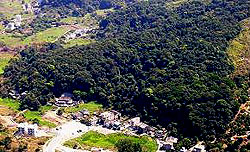 Sites of Special Scientific Interest (SSSI) may be land-based or aquatic sites, which are of special scientific interest because of their flora, fauna, geographical or geological features. The Department continues to patrol and monitor the conditions and scientific values of all SSSIs. Where warranted, the Department also carried out appropriate habitat management work at some SSSIs to maintain or enhance their scientific value. For instance, Mikania control was conducted at the A Chau SSSI to improve the condition of the trees at the site for egrets and herons to nest. The Department also continues to review the status of SSSIs and identifies new sites suitable for SSSI listing. In 2005-06, three new SSSIs were listed, namely South Tsing Yi for the protection of the endemic plant species Croton hancei, Tai Om Fung Shui Woodland and Shek Ngau Chau, which is Hong Kong’s most important breeding ground for terns. Sites of Special Scientific Interest (SSSI) may be land-based or aquatic sites, which are of special scientific interest because of their flora, fauna, geographical or geological features. The Department continues to patrol and monitor the conditions and scientific values of all SSSIs. Where warranted, the Department also carried out appropriate habitat management work at some SSSIs to maintain or enhance their scientific value. For instance, Mikania control was conducted at the A Chau SSSI to improve the condition of the trees at the site for egrets and herons to nest. The Department also continues to review the status of SSSIs and identifies new sites suitable for SSSI listing. In 2005-06, three new SSSIs were listed, namely South Tsing Yi for the protection of the endemic plant species Croton hancei, Tai Om Fung Shui Woodland and Shek Ngau Chau, which is Hong Kong’s most important breeding ground for terns.
CONTROL OF MIKANIA
Mikania (Mikania micrantha) is an exotic climber which grows rapidly in open and disturbed areas such as roadsides and derelict land. Overgrowth of Mikania causes damage to other plants by cutting out light and smothering them. Since Mikania seldom grows in the shade, it has not had an adverse impact on established woodlands with large trees and a close canopy.
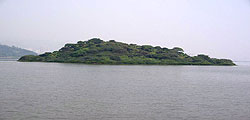 To prevent the proliferation of Mikania in sites of conservation value, the Department continued to deploy manpower and resources to clear the plant when found in country parks, special areas and SSSIs. Besides mechanical weeding and a field trial on the application of sulfometuron-methyl herbicide, a holistic approach through habitat management is also under trial at certain sites. As Mikania has a lower germination rate and growth rate in shaded environments, planting trees and shrubs at infested sites after the clearance of Mikania could theoretically provide the necessary shaded environment to suppress the weed from regenerating. Preliminary field observations show that the regeneration of Mikania at such sites was much reduced after the establishment of new plantings. However, intensive maintenance work such as the use of weed mats and frequent weeding was needed in the initial period to control the regeneration of Mikania so as to ensure the healthy growth of the plantings. Considering the resources implication and other site constraints, this approach has only been applied at certain ecologically important sites such as A Chau. To prevent the proliferation of Mikania in sites of conservation value, the Department continued to deploy manpower and resources to clear the plant when found in country parks, special areas and SSSIs. Besides mechanical weeding and a field trial on the application of sulfometuron-methyl herbicide, a holistic approach through habitat management is also under trial at certain sites. As Mikania has a lower germination rate and growth rate in shaded environments, planting trees and shrubs at infested sites after the clearance of Mikania could theoretically provide the necessary shaded environment to suppress the weed from regenerating. Preliminary field observations show that the regeneration of Mikania at such sites was much reduced after the establishment of new plantings. However, intensive maintenance work such as the use of weed mats and frequent weeding was needed in the initial period to control the regeneration of Mikania so as to ensure the healthy growth of the plantings. Considering the resources implication and other site constraints, this approach has only been applied at certain ecologically important sites such as A Chau.
|